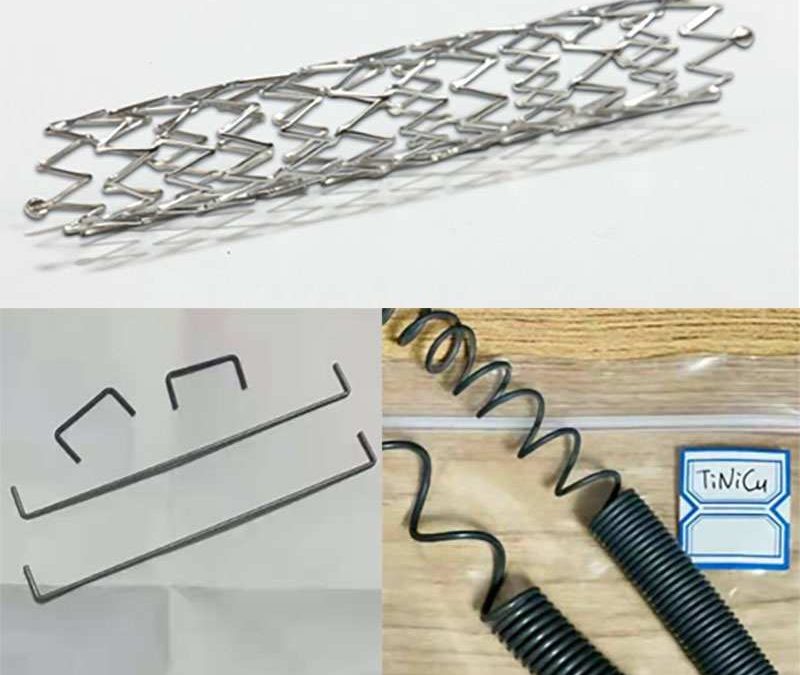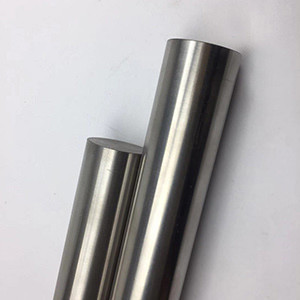Nitinol alloys (nickel~titanium alloys) exhibit a combination of properties which make them particularly suitable for the manufacture of self-expanding stents. Nitinol alloys are rapidly becoming the materials of choice for use in self-expanding stents, graft support systems, filters, baskets and various other devices for interventional procedures.
The best-known properties of nitinol alloys are their superelasticity and [hennal shape memory. While the term ‘shape memory’ describes the phenomenon of restoring a predetennined shape by means of hearing, having ‘plastically’ deformed that shape, the tenn superelasticity refers to the enormous elasticity of these alloys, which can be IO times greater than the best stainless steels used in medicine today. Although both effects are clearly spectacular, they are not the only important properties of the material. In this paper, features such as biomechan ical compatibility, constancy of stress, dynamic interference and ‘biased stiffness’ will be described. In combination with strength, fatigue resistance, biocompatibility and MRI compatibility, these nitinol-specific properties allow interesting solutions for the design of superior medical devices.
Superelasticity and shape memory of nitinol
Conventional metallic materials such as stainless steel, titanium which are used in stents, filters an d other interventional devices, exhibit a distinctly different elastic deformation behaviour from that of the structural materials of the human body. The elastic deformation of these metals and alloys is limited to “,1 % strain and elongation typically increases and decreases linearly (proportionally) with the applied force. In contrast, natural materials such as hair, tendon and bone can be elastically deformed, in some cases, up to 10% strain in a non-linear way When the deforming mess is released, the strain is recovered at lower stresses.
A similar behaviour is found with nitinol alloys, which are equiaromic or near-equiatomic intennetanic compounds of titanium and nickel. as will be shown later, the properties of nitinol alloys are strongly temperature dependent). As with natural marerials, the loading and unloading curves show plateaus, along which large deflections (strains) can be accumulated on loading, or recovered on unloading, without a significant increase or decrease respectively in load (stress). Because a deformation of more than 10% strain can be elastically recovered, this behaviour is called ‘superelasticity’ or sometimes more scientifically ‘pseudoelasticity’. It is the basis for most applications of nitinol in medical devices.
Elastic deployment
The enormous elasticity of nitino! allows such alloy devices to be introduced into the bod)’ through catheters or other delivery systems with a small profite. Once inside the body, the devices can be released from their constraints and unfolded or expanded to a much larger size. the elastic deployment of a stent of 20 mm diameter from a 3 mm i.d. cartridge. In order to fully expand at body temperature (37″C) the transition temperature of the alloy shou ld be :530OC. If full deployment is required at room temperature (w·e) the transition temperature of the alloy should be :515°C. Typical expansion ratios for self expand ing nitinol stents range between 1:2- 1:5. As with stents, filters and occlusion devices (atrial septal defect occlusion, Botalli duct occlusion) can be deployed superelastically through small-sized catheters. Nitinol is also used in retricval baskets and snares.
Thermal deployment
A stent with a transition temperature of 30℃ can be compressed at :520·C. It will stay compressed until the temperature is increased to > 30″C. It will then expand to its pre-set shape. If this stent could be kept cold during introduction into the body it would not expand. Whcn positioned at the desired location it would warm up by means of body heat and expand. However, this is difficult to accomplish. All self-expanding stents are therefore constrained in the delivery system to prevent premature deployment. Stents could theoretically be built with a transition temperature of 40·C. These stents would have to be heated after delivery to the site to make them expand.
Constant force (stress)
An important feature of superelasric nitinol alloys is that their unloading curves are flat over a wide defl ection (strain) range. This allows the design of devices that apply a constant force or load (stress) over a wide range of shapes. Stents deployed in vessels therefore exert an almost constant force independent of the amount of unresolved recovery. (Note: it is typically recommended that stents with diameters 1-2 mm greater than the vessel diameter are used.) The orthodontic archwire was the first product [0 use this property. Stainless-steel and other conventional wires are regularly tightened by the orthodontist. As treatment continues, the teeth move and the force applied by stainless-steel wires quickly relaxes according to Hooke’s law. This causes treatment to slow, retarding tooth movement. In contrast nitinol wires are able to ‘move with rhe teeth’, applying a consrat)[ force over a very broad range of treatment times and tooth positions.
Dynamic interference
Self-expanding nitinol stents will always expand to their pre-set diameters with no recoil, while balloon-expandable stents have to be over-expanded to achieve a certain diameter (d ue to elastic spring-back after deflation). The· nitinol stent will continue to gently push outwards against the vessel wall after deployment. Typically, the pre-set diameter of a nitinol stent is ,., 1-2 mm greater than the target vessel diameter. It witl therefore try to reach this diameter. Should the vessel increase in d iameter the nirino l stent will also expand until it reaches its final d iameter.
Biased stiffness (force hysteresis)
The most unusual feature of nitinol alloys is force or load hysteresis. While in most engineering materials load (or stress, if nonnalizLod) increases linearly with deflection (strain) upon loading and decreases along the same path upon unloading, nitinol exhibits distinctly differem behaviour. After an initial linear increase in load with deflection, large deflections can be obtained with only a small further load increase. This is called the loading plateau. The end of this plateau is reached at … 8% strain. Unloading from the end of the plateau region causes the load to decrease rapidly until a lower plateau {the ‘unloading plateau’} is reached. Deflection is recovered ill thiS region with only a small decrease in load. The last portion of the defonning strain is finally recovered in a lillear fashion. The unloading stress can be as low as 25% of the loading stress.
Kink resistance
Nitinol wires. by vinue of their kink resistance and torquability, have been used to make guidewires since the early 1980s. These wires can be bent 10 times more than stainless-steel wire without permanent deformation. For example, a 0.035 in. diameter nirinol wire can be wrapped around a 0.5 in. diameter mandrel withom being permanently deformed, whilst a stainless-steel wire of the same diameter can only be bent around a 5 in. diameter mandrel without being plastically deformed.
Kink resistance is an important feature of nitinol for stems in superficial vessels that could be deformed by external forces. The carotid artery is a prime example. There is a perceived risk that balloon.expandable stents deployed in carotid arteries can be permanendy deformed by external pressure, resulting in a partially or completely blocked vessel once the buclcJing strength of the stent has been exceeded. A lthough nitinol stems typically do not have the buclcling strength of stainless-steel stems, they cannot be permanently deformed by external forces. Nitinol stents can be completely compressed (crushed) flat and will rerum to their original diameter when the deforming force is removed.
MRI compatibility
Nitinol is non·ferromagnetic with a lower magnetic susceptibility than sta inless steel. MRI compatibility is directly related to the susceptibility properties of a material relative to human tissue. Therefore, nitinol produces fewer artefactS than stainless steel, and is similar to pure titanium in this regard.Most features of the stent are clearly visible. It has to be noted, however, that processing of the material can Signifi cantly infl uence the quality of the MRI image.
Biocompatibility
Nitinol alloys contain a higher proportion of nickel than stainless Steel. This causes understandable concern because nickel is considered to be toxic. However, as nitinol is an intermetallic compound and not an alloy in the metallurgical sense, the bonding force of nickel to titanium is much stronger than that of nickel to the alloy components in stainless steel. Moreover, as nitinol oxidizes after proper sumce treatment it forms a TIOz layer with no nickel present at the surface. Polarization testing in Hank’s solution has repeatedly shown that nitinol is chemically more stable and less corrosive than stainless steel .
Radiopacity
Nitinol produces a fluoroscopic image comparable to that of stainless steel if the mass and dimensions of the parts examined are similar. Although this degree of radiopacity is sufficient in many cases, an improvement would be beneficia l. While stainless steel can be gold- plated, for example, with sufficient thickness to enhance radiopacity, layers of gold and other radiopaque materials might negatively infl uence the superelastic performance of nitinol.
Making Nitinol Devices
Hot working of this material is relatively easy than cold working. The enormous elasticity of this material makes cold working difficult by increasing roll contact. This results in extreme tool wear and frictional resistance. These reasons also make machining of this alloy extremely difficult. The fact that this material has poor thermal conductivity does not help in this purpose. It is relatively easy to perform Grinding, laser cutting and Electrical Discharge Machining (EDM) on this metal.
Heat treatment of this material is very critical and delicate. The heat treatment-cold working combination is important for controlling the useful properties of this metal.
Nitinol Wires
Nitinol is used for making shape-memory actuator wire used for numerous industrial purposes. This wire is used for guidewires, stylets and orthodontic files. This wire is ideal for applications requiring high loading and unloading plateau-stresses as well as for eyeglass frames and cell phone antennas. However, the main uses of this wire are in stents and stone retrieval baskets.
Nitinol Stent
Nitinol alloy is used for manufacturing endovascular stents which are highly useful in treating various heart diseases. It is used to improve blood flow by inserting a collapsed Nickel titanium stent into a vein and heating it. These stents are also used as a substitute for sutures.
Nitinol Basket
Nickel titanium wire baskets are well-suited for many medical applications as it is springier and less collapsible than many other metals. This basket instrument is highly useful for the gallbladder.
Nitinol Availability
Nitinol alloys is available in various forms including nitinol wires, nitinol tubes,nitinol sheets and nitinol springs. XOT is one of the leading manufacturer and supplier of this nitimoll alloy..For more detail or technical support of nitinol alloys ,please contact us.


